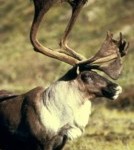By CAMERON SMITH
 Ontario's herds face many threats
Ontario's herds face many threats
They are elusive and, well, gracious, which the dictionary defines as affable and, in a loose sense, elegant. The forest-dwelling woodland caribou, in turn, define the wilderness in Ontario's boreal forest. They are an indicator species — and they may be doomed. Already they are designated as threatened.
There are only about 5,000 of them left in Ontario, and they live in a delicate balance that can easily tip the wrong way.
But caribou are adaptive, and they could well meet the challenges, were it not for the constant incursions into their habitat by logging and mining companies. Only if these are curbed will they have a fighting chance.
There are about 1.3 million caribou in Canada, almost all of them barren-ground caribou in the Arctic. Woodland caribou are a distinct subspecies, and of them, those that dwell in the boreal forest are a separate ecotype.
Ontario has a draft recovery plan for the 5,000 in its boreal forest. It says global warming will bring more fires, and more severe fires, which will change caribou habitat and attract more deer — and deer will bring wolves, the caribou's main predator, as well as the parasitic meningeal worm, which is fatal to caribou.
A report by the independent federal agency responsible for designating species at risk says weather affects all aspects of the ecology of caribou, but "its effects ... are often indirect and subtle — a small decline in pregnancy rates (for instance)."
This may not sound serious, but it is, the report says, because a slight decline in birth rates or a slight increase in mortalities could send the population spiralling downward since they already lead a precarious existence.
Pregnant females and calves are particularly vulnerable, with only 30 to 50 per cent of calves surviving beyond their first year. To escape wolves, black bears, wolverines and lynx, pregnant females often give birth in wet peatlands, where predators don't follow. But will global warming dry out some of the peatlands? Already it has happened in Saskatchewan and Alberta where large fires have taken hold of dried-out peatlands.
Global warming will bring more diseases and insects to damage the forest itself and limit caribou habitat. There'll also be more warble, nose bot and blackflies, mosquitoes, and horse and deer flies to torment caribou, whose summer behaviour is "greatly influenced by attempts to reduce exposure to insects," the federal report says.
But what is known is that the rate of pregnancies drops as the number of warble flies increases in females. Moreover, the ability of calves to survive depends in part upon birth weight, which is determined by the ability of mothers to forage during the previous year. Will harassment limit foraging? It's not known.
Global warming is also expected to produce heavier but less frequent rainfall, which leads to drier soils. And an increase in snowfall, with possibly more crusting of the snow could result, which would slow down the caribou while allowing predators to race across the crust.
It all adds up to loss of habitat, more predation, greater vulnerability of pregnant females and calves, more disease, changing composition of the forest, and an increase in insect harassment. The cumulative impact makes it extremely important to preserve large tracts of connected forest to increase options for caribou survival.
The draft recovery plan says "recovery will be an extremely difficult, expensive and long-term initiative at ... a scale (in territory and time) not previously required under other provincial species recovery strategies ... (It) will require a sustained commitment ... over many decades."
The plan also warns that forest companies will face a loss of wood supplies, mining companies will object to restrictions on exploration and development, and from moose and deer hunters there will be strong resistance to closing roads into caribou habitat.
The challenge for the public will be to keep Queen's Park from caving in to those who want to continue their incursions into caribou habitat.



